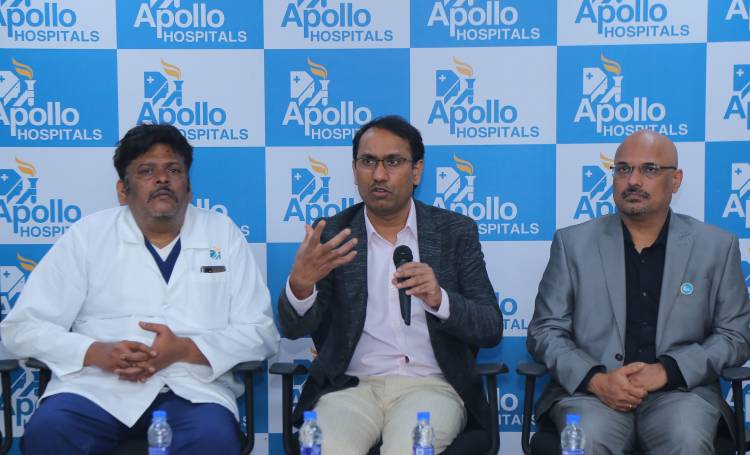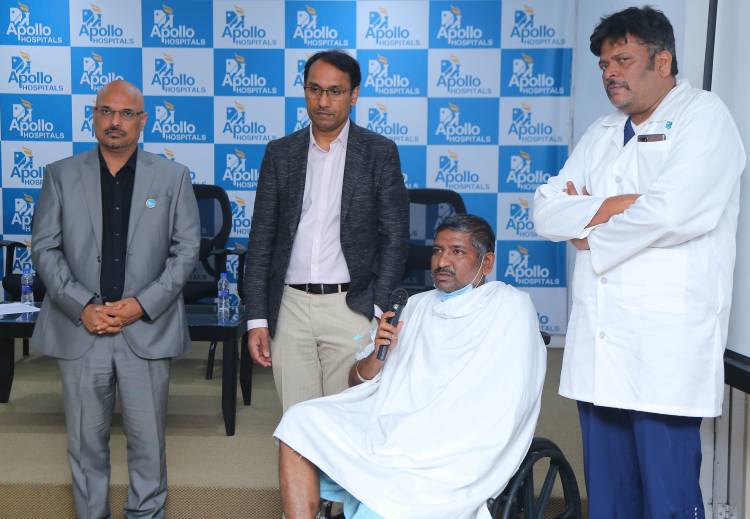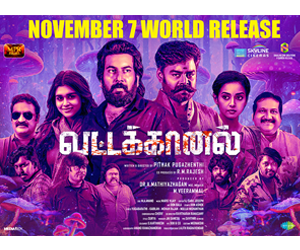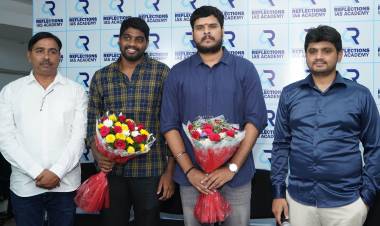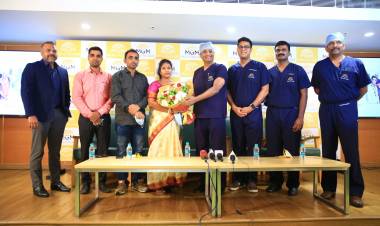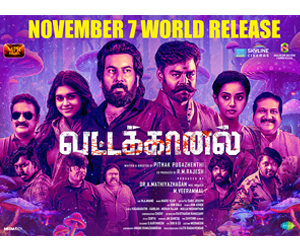Apollo Hospitals introduces a novel foot reconstruction treatment for Diabetic patients, instead of leg amputation!
Apollo Hospitals introduces a novel foot reconstruction treatment for Diabetic patients, instead of leg amputation!
Launches a Centre of Excellence for Diabetic Foot Management to provide succor to diabetic patients
The Centre offers complex diabetic foot deformity correction surgeries that enable limb preservation and mobility, for the first time in the country
60-70% patients undergoing amputation don’t survive beyond 5 years, this surgery ensures better quality of life
Hyderabad, April 27th, 2022: Apollo Hospitals launched a unique multidisciplinary Centre of Excellence for Diabetic Foot Management (CoEDFM), for diabetic patients, known to be prone to foot related ailments, at its premises at Jubilee Hills. Apollo Hospitals in collaboration with the King's College Hospital, London; will make a novel Diabetic Foot Reconstruction & Management procedure, available for the first time in the India, for patients at the Centre of Excellence for Diabetic Foot Management at Apollo Hospitals. This new procedure was developed by Dr Venu Kavarthapu, a World-renowned Orthopedic Surgeon & Consultant at King's College Hospital, London.
CoEDFM will follow a multi-disciplinary treatment protocol for the festering foot related ailments, which can often be traumatic and life threatening for diabetic patients. To render a comprehensive and holistic care to the most dreaded problem among diabetics, Apollo Hospitals has set up a team of specialists as part of CoEDFM, comprising of Podiatric surgeons, Vascular surgeons, Orthopaedic surgeons, Infectious disease specialists, Physical therapists and Orthotists. The team will work collaboratively to address medical optimization, arterial perfusion and infection eradication in order to ensure a functional leg, ankle and foot.
Speaking on the occasion Dr Venu Kavarthapu said, what happens in Diabetics is, because of the damage to the nerves, vessels and the bones, the foot gets twisted or deformed, unless we untwist the foot and correct the deformity, the patient can’t walk well. Patients with diabetic foot problem if they can’t remain mobile, they develop bigger problems, the heart gets weakened, kidney problems, impacting brain blood circulation resulting in stroke and multiple problems. It’s really important that we maintain their mobility, taking their leg off, amputating the leg is not ideal in those group of people either. Those people with diabetes if they lose their leg, there is so much scientific evidence available for more than three decades that they end their life early, about 60% to 70% die with in 5 years, which is not acceptable. We decided to try and develop a more reliable surgical technique and develop the instrumentation, special devices to provide a reliable and predictable solution for this really complex problem. So, this unit where I work and head as a reconstructive lead at King's College Hospital Diabetic Foot Unit in London, I have done more than 170 specific complex diabetic foot reconstructions and we are very pleased with the results and those results are globally recognized and many countries follow such similar protocol. I feel so fortunate to be able to provide that service to my people in India, I am so grateful to Apollo and my friend Dr Srinivas Seshabhattaru, for joining up with us to deliver this service to our own people. Often patients who are recommended for amputation come to us. We already started treating patients at the Centre of Excellence for Diabetic Foot Management at Apollo Hospitals. With an already well established and amazing primary foot care, Apollo has through Apollo Sugar Clinics, most of the patients don’t reach a chronic stage. Some of them develop bigger problems, those patients require secondary care and we already have a fantastic center here at Apollo Hospitals, Jubilee Hills, headed by Dr Srinivas, providing the secondary care. But what we are going to introduce from now on which hasn’t been available in this country in a structured manner is to provide the high-end tertiary care for those patients who come with severe deformity or foot become too wobbly, unstable, if the infection gets bad, all of these are normally managed with amputations usually in many centers. But what we are going to offer is this advanced diabetic foot limb reconstruction service. The goal here is not to just retain the limb, but to retain the functionality so that patient can walk and have a decent lifestyle. The material used for diabetic foot reconstruction has to be much stronger than the ones we use for routine fractures. For the bones breaks we use similar types of plates and screws, they need not be so strong, because the bone break heals generally in 6 to 8 weeks. But these take long time to heal so the metal has to be very reinforced, very strong so they are all made of reinforced titanic alloy and the geometry of the fixation tower has to be specific. So the mantra used for the fixation device is called a Long segment rigid fixation with optimal bone position. Normally if the same bone gets fractured in non-diabetic patient, we just fix those two ends together, it’s called short segment, where just that segment is fixed. For diabetic foot if you just fix that segment, that segment breaks again. Two to three decades ago when doctors tried to fix these it failed, the doctors at that time declared that you should never operate, just amputate. But what other clinicians did was, if we do use the long segment fixation they don’t break, they don’t fail so easily. But that segmentation has to be very rigid, there shouldn’t be any motion until the bone heals, there shouldn’t be even micromotion, it has to be rigid fixation. These devices are not only made of strong material, but they have to applied in an engineering manner in a certain way so that we get that rigid long segment fixation, there shouldn’t be any gaps between the bones then the bones join. To our pleasant surprise till 20-30 years ago there was a view that they never join, they do join, if we do in a one particular way and we have shared our experience through scientific publications and now there is a wider usage of this principle.
Diabetics suffer from neuropathy or weakness and dysfunction of the nerves of the lower limb that leads to loss of protective sensation. This lack of sensation results in patients unknowingly injuring their feet, which won’t heal quickly. Patients in addition could develop altered gait or walking patterns. Injury in areas of high pressures in the weight bearing skin or soles of the feet is common too. These progressively lead to foot deformities and formation of foot ulcers that are difficult to heal and when infected pose a threat of losing the limb or needing amputation of the legs. The other major issue is progressive reduction in blood flow to the limbs that results in painful nonhealing ulcers and reduced ability to heal wounds and sometimes leads to gangrene, which is death of tissue that is irreversible.
As part of the protocol designed by CoEDFM, specialists led by Podiatric surgeons perform comprehensive foot evaluations for high-risk patients, screen for factors that could lead to diabetic foot complications. The Team of specialists at CoEDFM, identify and curtail Diabetic Foot disease early and provide succor through various foot care options.
They prescribe customized footwear or molded inserts for foot deformities. Help use customized braces and therapeutic, prescription diabetic footwear to prevent the formation of foot ulcerations or even to heal ulcers. In instances, apply advanced wound healing technologies like Bioengineered tissues like amniotic tissues, living cell therapies, negative pressure wound therapies, total contact casting and other advanced therapies to heal wounds expediently. After healing ulcers early, the foot is made stable and functional weight bearing through offloading surgeries and modern advanced reconstructive surgeries to correct Foot deformities, correct Biomechanical discrepancies and Charcot foot stabilization.
Despite optimal preventative measures, some patients with diabetic foot problems develop severe deformities and infection, resulting in amputation. CoEDFM now offer complex diabetic foot deformity correction surgeries that allow to retain the leg and mobility.
The nerves of Diabetic patients become weak in 8 to 9 years of diabetes and is called diabetic neuropathy, with this ailment they can’t put their foot firmly and that variation in the walk leads to areas of sole developing boils due to uneven pressure. If it is ignored, the sense of touch and pain is lost in that area and will become wounds called neuropathic ulcer. To heal the wound, we need to ensure proper placement of the foot while walking to reduce the pressure in the area. This can be healed by special footwear. If we don’t intervene in right time the foot gets deformed leading to ucers, which don’t heal and lead to deformity. Such deformed foot are reconstructed through this new surgery. Even though a major amputation is a quick and easy procedure to do, most such patients do not achieve ambulatory status after surgery. Due to the complications related to reduced mobility about 70% of these patients die with in 5 years. The patient can retain mobility if the deformed and infected diabetic foot is reconstructed so that the foot becomes stable and normal shaped, says Dr Srinivas Seshabhattaru, Consultant Podiatric Surgeon Apollo Hospitals, Jubilee Hills.
Dr Ravindra Babu, Director Medical Services, Apollo Hospitals, Jubilee Hills; said, we all know that diabetes is a huge burden, chronic diabetes leads to foot ulcers and ultimately the foot is amputated. Preventing amputation and retaining the patient’s leg is the challenge we are addressing. Dr Venu Kavarthapu has found a solution and patients that would have lost the leg are able to walk. Now this surgery is available at Apollo Hospitals, Hyderabad, we performed some complicated surgeries. These surgeries have never been attempted in our country and are being done for the first time.
The new technique uses the international fixation method using special devices including beams, bolts and specially designed plates and nails. These techniques were developed, and some devices designed by Prof Venu Kavarthapu at King's College Hospital in London, and this resulted in marked improvements in the success rates. The Specialists at the Centre of Excellence for Diabetic Foot Management, at Apollo Hospitals, Jubilee Hills, have acquired the required reconstruction skills and specialized technologies and are geared to perform these complex surgeries with great finesse and help diabetic patients to mitigate their suffering
About Apollo Hospitals
It was in 1983, that Dr Prathap C Reddy made a pioneering endeavor by launching India’s first corporate hospital - Apollo Hospitals in Chennai. Now, as Asia’s foremost trusted integrated healthcare group, its presence includes over 12,000 beds across 72 Hospitals, 4500+ Pharmacies, over 120 Primary Care clinics and 700+ Diagnostic centers, 500 plus Telemedicine Centers, over 15 medical education centers and a Research Foundation with a focus on global Clinical Trials, epidemiological studies, stem cell & genetic research, Apollo Hospitals has been at the forefront of new medical advancements with the most recent investment being the commissioning of South East Asia’s very first Proton Therapy Centre in Chennai.
Every four days, the Apollo Hospitals Group touches a million lives, in its mission to bring healthcare of international standards within the reach of every individual. In a rare honor, the Government of India had issued a commemorative stamp in recognition of Apollo's contribution, the first for a healthcare organization. Apollo Hospitals Chairman, Dr Prathap C Reddy, was conferred with the prestigious Padma Vibhushan in 2010. For 37 years, the Apollo Hospitals Group has continuously excelled and maintained leadership in medical innovation, world-class clinical services and cutting-edge technology. Its hospitals are consistently ranked amongst the best hospitals in the country for advanced medical services.
For further details, log onto: www.apollohospitals.com
Follow us on Twitter: @HospitalsApollo


